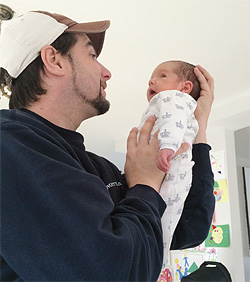Head

![]() The baby’s head is large and heavy. It needs to be supported when you pick him up.
The baby’s head is large and heavy. It needs to be supported when you pick him up.
Your baby has a delicate neck, but should be able to turn it sideways easily. If he has trouble moving it and it seems to hurt, he may have a stiff neck. If the stiffness persists, get advice from a health professional.
Pressure during labour and delivery sometimes deforms your baby’s head. It will regain its round shape in a few weeks. The bones of the skull are not yet knitted. They are attached by a diamond-shaped membrane, the anterior fontanel.
Located on top of the head, the anterior fontanel is supple to the touch and forms a small depression when your child is sitting. You can sometimes see it beating with the heart. A smaller triangular fontanel is located on the back of the head. Fontanels are the most fragile areas of the head, but you can safely wash them and touch them gently. The bones of the skull will knit between 9 and 18 months, and the fontanels disappear.
A bump or swelling containing blood and/or other liquid may be visible beneath the scalp. It will cause the brain no harm and disappear without a trace, usually in a few days.


